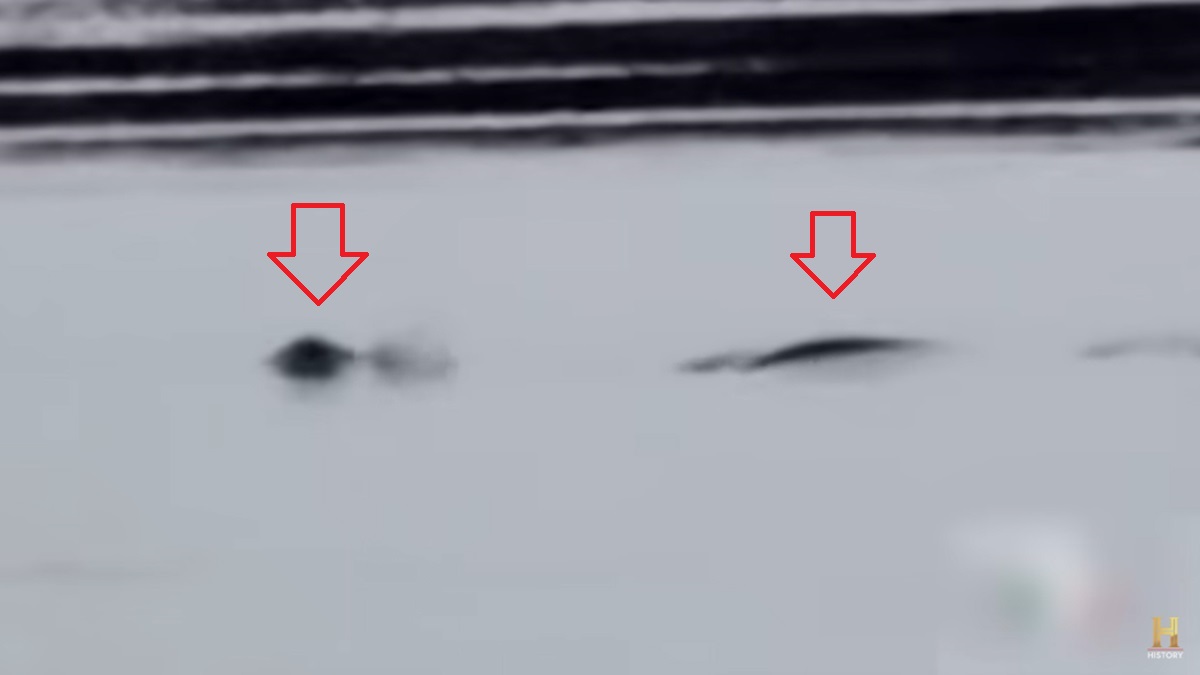
Kelly Nash’s 2009 footage allegedly shows a Cadborosaurus in Nushagak Bay, Alaska. Pic credit: via History/YouTube
New evidence allegedly emerged in 2009 that the legendary Nessie-like Cadborosaurus might not have been the product of the imaginations of previous witnesses.
The alleged evidence from the 2009 sighting suggested that the elusive Cadborosaurus, native to Cadboro Bay, B.C., may have extended its range to Alaska.
In 2009, Alaskan fisherman Kelly Nash captured footage purportedly showing a serpentine creature swimming in Nushagak Bay, southwest of Alaska.
He did not go public with the footage until two years later when he shared it with Discovery Channel’s Hillstranded.
An episode of The Proof Is Out There with Tony Harrison on the History Channel investigated the alleged Cadbosoraus encounter. Harris presented the evidence, including raw video and expert analyses (see video below), to let viewers judge themselves.
Cadborosaurus: Rare glimpse of an elusive sea serpent?
Nash was fishing in Nushagak Bay with two sons when they noticed a disturbance in the water close to their boat. The eddy looked so unusual that the veteran fishermen started recording.
Unfortunately, their videography skill was nothing compared to their fishing skills. The resulting shaky footage was lacking in clarity and focus.
However, compared with its Scottish cousin, the Loch Ness Monster (Nessie), Caddy is a notoriously elusive creature. Thus, the rare glimpse of the shy creature offered by the video caused considerable excitement among professional and amateur cryptozoologists.
Dark serpentine monster about 20-30 feet.
The footage showed what seemed a dark serpentine monster surfacing discreetly. The creature with humps on its back swam swiftly through the water. As it moved along, its head appeared momentarily above the water.
The witnesses later estimated the creature at about 20-30 feet.
Marine monster was likely Cadborosaurus
Cryptozoologists who viewed the footage agreed it was most likely a Cadborosaurus.
Cryptozoologist Ken Gart told Harris that previous sightings in the Pacific Northwest region suggested the creature could reach 60-100 feet.
It has an equine head, a long neck, a mane, a row of sharp saw-like teeth, large eyes, and an overhanging upper lip.
Other witnesses claimed it has front and back flippers resembling a walrus or sea lion.
Cadborosaurus sightings
One of the earliest sightings occurred in 1933 when a couple from Victoria claimed they saw a serpentine creature in Cadboro Bay.
Two fishermen reported an encounter in 1934. The fishermen claimed they saw a pair swimming together
Captain Paul Sowerby reported a sighting in 1937. Captain William Hagelund claimed he caught a juvenile “sea serpent” near De Courcy Island, off the B.C. coast.
But in 2011, the British paleontologist Darren Naish announced that the creature Hagelund caught was most likely a Bay pipefish (Syngnathus leptorhynchus).
Later, in 1995, cryptozoologists Edward L. Bousfield and Paul H. LeBlond announced they had found photographic evidence of Cadborosaurus. They stumbled on old photos that whalers at the Narden Harbor Whaling Station in the Queen Charlotte Islands, off the coast of B.C., snapped in 1937.
The photos allegedly showed the carcass of a vertebrate animal recovered from the stomach of a sperm whale.
The cryptozoologists believed it was a Caddy, but local experts thought it was likely the unborn of a baleen whale.
Theory: Cadbosaraus is a surviving ancient Basilosarus
A theory soon gained traction among cryptozoologists that Caddy was a surviving species of ancient Basilosarus, a fearsome, predatory whale-like marine monster from the late Eocene (41.3-33.9 mil years ago).
However, marine biologist Sheanna Steingass told The Proof Is Out There that the body type of the Basilosarus was not serpentine but whale-like. Thus, in her opinion, she did not think the creature in the footage was an ancient Basilosarus.
She also noted that descriptions of Caddy suggested it was a reptilian creature. According to Steingass, a serpentine reptilian creature could not survive in the cold waters of Alaska.